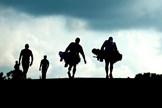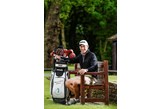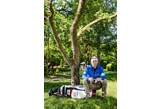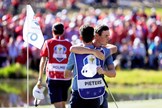Bags to riches: The truth about caddieing on Tour
Published:
MEET THE CADDIES
Dermot Byrne: Caddies for: Shane Lowry. Started caddieing: “In 1996; this is my seventh year with Shane.” Worked for: Peter Lawrie and Steven Gallacher
Adam Marrow: Caddies for: Thomas Pieters. Started caddieing: “This is my 12th year.” Worked for: Ross Fisher and Lucas Bjerregaard.
Cliffie Botha: Caddies for: Miguel Angel Jimenez. Started caddieing: “In 2002, with 13 years on the European Tour.” Worked for: James Kingston, Thomas Aiken
Guy Tilston: Caddies for: Oliver Fisher. Started caddieing: “This is my 31st year.” Worked for: Eamonn Darcy, Simon Dyson, Thomas Bjorn

Caddieing on tour is tough, and it can also be cruel. Tales from beaten and battered bagmen are not in short supply. Caddies typically receive five per cent of a player’s earnings for making the cut, seven for finishing in the top 10 and 10 per cent for a win. But what’s five per cent of nothing if your man misses the cut?
Sure, some caddies are rolling in it – Jordan Spieth’s caddie, Michael Greller, made an estimated $2.14 million in 2015. But for every Greller there are dozens more caddies scrabbling for a living – even if any living on tour sounds more fun than a normal job, with global travel, adrenaline rushes and the prospect of a big salary some of the perks.
“Caddies have everything on a plate for them – transport every week and food laid on,” says veteran caddie Guy Tilston. “About 20 of us used to go on a train and three would look after the bags and we’d split up like Red Arrows looking for digs, often sleeping four or five in a room! We even camped – it was a real adventure. Sometimes you wouldn’t break even, but it was worth it in the long run.”
Tilston, 51, is now with Oliver Fisher after parting company with Thomas Bjorn earlier in the season. He said: “It didn’t work, not for either of us really. We didn’t gel.”
But there’s no HR department for caddies to turn to if things go bad, no tribunals for unfair dismissal. For many, though, the thrill of the chase – and the chance of making it big – is enough to keep them out there…

Sum up being a Tour caddie in a nutshell?
DB: You have good weeks, which are fantastic, and bad weeks, which are terrible. It runs very much parallel to how your golfer is playing.
AM: At the start of the year you’re thinking: ‘Am I going to break even or am I going to make money?’ That’s the reality of it. Some years you can be close to losing money out here. It’s quite a financial gamble and there’s a lot of uncertainty, which can be tricky if you’ve got a mortgage and bills to pay.
CB: I’d been playing on and off on the Sunshine Tour for 10 years and arrived at a point where I wanted a better living because
I wasn’t earning much. A friend asked me out of the blue if I wanted to caddie for him and that’s where it started.
GT: I’ve had 14 wins but it’s tough to win; you’ve got to get lucky and be in the right place at the right time.
What’s been the highlight of your career?
DB: Winning the World Golf Championship at Akron was the best one as a caddie. It’s massive to win in the same field as a Major on a Major-style course.
AM: The journey with Ross Fisher, from graduating from the Challenge Tour to the top 50 in the world, playing in all the Majors, winning three times and getting to No.17 in the world.
CB: My first 10 years was a learning experience – it’s a different ball game with Miguel, he’s a different quality player. We’ve won six tournaments together now, three on the European Tour, and him winning his first Spanish Open was special. But a win is a win.
GT: Winning the Dunhill Links with Simon Dyson at the Home of Golf, walking down the 18th in such circumstances is a special feeling.

What about the lows?
DB: Unfortunately there’s a lot more of these. That’s the nature of the business. To be honest I can’t point my finger at a single one.
AM: I was gutted I never got the chance to win with Lucas Bjerregard because he’s a really good guy. I feel like if I’d worked for him a year or two down the line things might have been different. I chose to stop working with him for personal reasons.
CB: In this line of work your emotions go very high and very low within one shot. The lows are when you go into big tournaments and there’s a lot at stake, only to miss the cut. But it’s part of the game, part of the work.
GT: In my first year with Marcel Siem they said if he won in Morocco he’d get in the Masters. He won, only to miss out on Augusta by 100th of a world ranking point! Obviously it was more cruel on him than me.
What’s the toughest part of the job?
DB: Being away from the family. Generally we work in three or four-week stints – not too bad when you’re doing well, but it’s like anything else, when you’re not doing so well, the caddie room is a lonely place.
AM: Caddieing is easy when your golfer is playing well. Pulling clubs, no problem – the player almost always makes you look good. But when he gets in a rut, misses a couple of cuts, that’s when caddieing is hard. There’s a lot more psychological stuff involved – you’re not on autopilot anymore. You’ve got to adapt to that and learning to adapt to that is when you become a good caddie. Good caddies come through when their players are not playing so well and get the best out of them, whether that’s making the cut by a shot or scraping a top-10 spot.
CB: Working days tend to be long and it’s 30-odd weeks away from home. But when I’m home I’m on holiday so I get 20-plus weeks holiday. Plus there’s the travelling, especially with Miguel playing on two Tours now between Europe and the US. Travelling, I would say, is the biggest challenge.
GT: I love it as soon as the gun goes off and the competition starts, although earlier in the week can be a bit boring. If you’re struggling, missing a few cuts, especially if you’ve got a family, it’s hard to justify being away.

And the best bit?
DB: Success. It’s very similar to playing. Having a good week is what it’s all about.
AM: There’s only one winner every week, 99 per cent of the time guys are failing. So when you’re associated with somebody who has won a tournament, it’s fantastic. I’ve been fortunate to have experienced five wins. Amazing feeling.
CB: Winning and getting the results that you work for. Miguel is a hard worker, he goes to the gym twice a day, he’s a committed guy and when you get the results you share the happiness with him – he’s the type of guy who involves you, wants you to be there. Walking down the 18th he’ll call you up and wait for you so we walk down there together.
Is it the next best thing to playing?
DB: If you’re more into the psychological side, you’re there to see the player at the highest point of his career and his lowest. I live on a golf course at Killeen Castle so I play when I can, off eight, but I don’t play enough.
AM: Without doubt. I grew up wanting to be a pro golfer so this is as good as it gets. I used to carry the scoreboards when I was a schoolboy and from inside the ropes I always looked up
to the players and caddies with admiration. To be one of those caddies and be able to give a ball away to a kid carrying a scoreboard is a nice feeling.
CB: It’s second best, you’re inside the ropes. Over the years it’s changed with more ex-players, ex-pros taking up the bag. We can still see all these great courses, we’re just not playing them! We see how it should be done.
GT: A lot of caddies are decent players with most from South Africa and Australia aspiring to become players. Not in my case – I originally got inside the ropes and started caddieing for pocket money. There are not many sports that enable outsiders to do this.

Do you still have a ball away from the course?
DB: That’s changed. It’s so professional now. Your night off is getting prepared for the next tournament. You’ve an opportunity to get yourself in a good financial place pretty quickly if you’re in the right job and do the job correctly, so there’s plenty of time off to get bevvied up.
AM: Drinking on Tour has pretty much gone now. There used to be quite a big drink culture, but nowadays caddies are nearly in the gym as much as players, and eating as well as many players. I love the saying ‘you’re only as good as your player,’ and although it’s a team effort, you still need to find yourself a good bag and are reliant on the talent of somebody else. You’re not entirely in control of your own destiny, but that’s the nature of the job.
CB: We still have a good time, although it’s not as it used to be – it’s a lot more serious and cut-throat. In the old days the boys went out for a beer, but now there are a lot of caddies looking for jobs so you don’t want to give the player an opportunity to fire you.
GT: It’s a lot different to 10 years ago. There’s not so much going on off-course, drinking and card games and so on. It was a lot more laid back and relaxed and there was a better atmosphere, although I understand things have had to progress. But there’s not so much camaraderie as there was.
What makes a top caddie?
DB: Knowing your player, knowing what to say at the right time. That’s it. Sometimes it’s a case of not saying anything at all.
AM: There’s a lot more to it than just carrying the bag. At times you’re touching on psychology, nutrition, as well as pulling clubs, wind direction, calculating yardages. You name it, we’ve probably done it.
CB: Everybody knows the basic rules: keep up, shut up and all that. But for me the thing is to keep your player happy. They know what they’re doing, we’re there to help them, to assess them and look after them. He’s got to trust you to do well. Do what he asks and provide him with the correct answers.
GT: Don’t over-analyse, give them freedom to use their natural ability and don’t blind them with science, saying the right thing at the right time and creating a positive atmosphere.
What advice would you give an aspiring caddie?
DB: There’s a few younger guys coming through and they’re so professional and good at their job. It’s a case of following what they’re doing.
AM: You need to be confident and to be able to make a decision. I don’t think there’s any room for ‘yes’ men out here – you have to say what you think and not be afraid of the consequences. Believe in what you’re doing.
CB: Not every caddie can work with every player so you’ve got to find the correct type of player – and then stick with it.
GT: Go to Tour school and then the Challenge Tour for a year, both great training grounds for caddies and players alike.
Experience is critical then?
DB: I’m fortunate I’ve been doing it a long time now so I know a lot of courses and what I’m doing. The job is a lot easier when you’ve got experience.
GT: You’ve made the mistakes and you learn from them. It’s gelling as much as anything, taking pressure off your player when he’s challenging. A lot of people have said to me they can’t tell whether we’re +6 or -6!
AM: I came on Tour at 20 and now I’m 32. Today, far more emphasis is put on the caddie who is more in the limelight so there’s more expectation – and pressure.
CB: You’re not going to be a good caddie from the beginning. They say only after five years are you actually a caddie – you learn a lot in that time.
What’s the most amusing thing you’ve seen?
DB: Shane said a couple of nasty words after finding water at the 15th in the Honda Classic and as we were walking down the fairway he asked ‘do you think I’ll get fined’ to which I replied ‘we’re lucky to be still here!’ Earlier, Smylie Kaufman also got wet and snapped his guilty 7-iron!
AM: It wasn’t funny at the time, but Thomas played the wrong ball on the third day in last year’s Czech Masters so it was a sleepless night on Saturday and pure relief he didn’t lose out by a single shot on Sunday!
CB: Miguel wears his heart on his sleeve and when he nails a shot or makes a hole-in-one there’s dancing involved, which not a lot of other players do. We have a lot of fun.
GT: Seeing Sam Torrance’s caddie Malcolm Mason slowly slide down a bank into the lake up to his waist at St Nom la Breteche… Even Nick Faldo burst out laughing, which was a rarity.
Has new tech like the Bushnell range finders made a big difference?
DB: A massive help. When I first started we used a wheel to register the measurements and you’re talking 6-12 hours of preparation and generally it was only an average guide what you were doing. Rangefinders have made life so much easier.
AM: I’ve always used Bushnell range finders, there’s been advancements and they’re good solid and reliable products.
CB: The biggest plus with them (range finders) is that they’re more precise. The old days involved a lot of guess work, but now we can trust the numbers.






